Eulero, also known as a Graeco-Latin Square or Euler Square, is a fascinating logic puzzle that combines elements of Latin squares and Sudoku.
In a hurry? Jump to: Rules / Tips / Worked Example / Video Tutorial / Free Puzzle Download / Books
Here’s what a small puzzle looks like:
The goal of Eulero is to fill the grid with letters and digits, which correspond to the size of the grid. In a 4x4 grid we use the letters A to D and the digits 1 to 4. A 5x5 grid uses A-E and 1-5, and so on. The cells are filled according to the following rules:
Here’s what our example puzzle looks like when complete:
If you’ve played Sudoku, the you’ll see that completing Eulero is a lot like completing a Sudoku puzzle. In fact, it’s almost like completing two superimposed Sudokus.
If you aren’t familiar with Sudoku, I’d highly recommend going through our comprehensive tutorial for that puzzle first, as it gives a good grounding in the basic techniques you can transfer to Eulero.
Solving Eulero puzzles then, is a case of following simple Sudoku logic to begin with.
Let’s look at a sample puzzle so we can see some of these techniques in action. Then you can try your hand at Eulero with our taster, below.
As always, although there is only a single valid solution to our puzzles, there are numerous ways of reaching it. This is not intended as a definitive path to solving this puzzle, just one possible path that can help demonstrate common solving techniques.

This is the puzzle we are going to solve. It’s pretty easy, ideal for learning on.
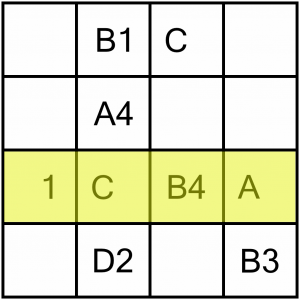
We can initially treat the puzzle like two independent Sudokus, one using letters the other using digits. The grid has eight letters and six digits, so it makes sense to look at the letters first.
This row is an easy win because we already have three out of the four letters. We just need the D in the first cell.
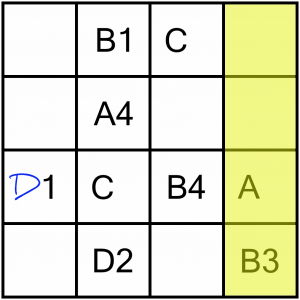
It’s easy to figure out where the missing C and D go in this column. Since the top row already has a C, we can’t put our missing C there, so it must be the D. That leaves only one place for the C.
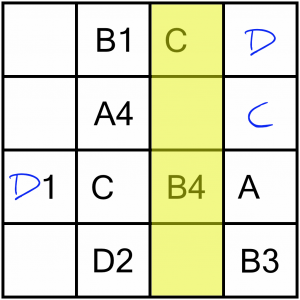
This is similarly trivial to complete given that we are missing an A and a D, and both can be found in the column immediately to the left.

That leaves three rows with one missing letter each, so we can fill those all in now.
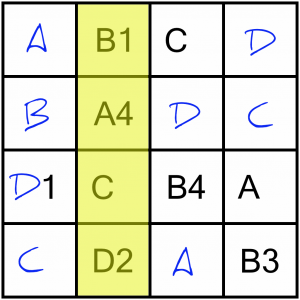
We’ve filled in all the letters, now we can turn our attention to the digits. Again, we’ll look for the easy wins first. This column is only missing a 3, so that couldn’t get any easier!

The knock-on effect of completing that cell is that we now have a row that’s only missing the 2, so we can fill that in.

These two cells can be completed because they require a 1 and a 4, and there’s only one way to fit them in without conflicting with the 1 and 4 in the second column.
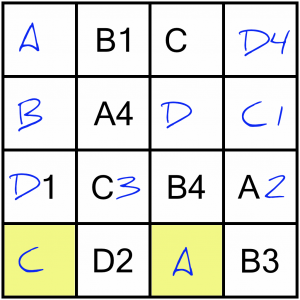
We have the exact same situation down here – we need a 1 and a 4 and there’s only one way to do that.

That just leaves four cells to complete. At this point we can remember that we are actually playing Eulero not Sudoku, and look at pairings.
We start with this A. We can see from the missing numbers in the row and column that it’s either going to be A2 or A3. A quick check across the board shows we have an A2 already. Duplicate pairs aren’t allowed, so our cell must be A3.
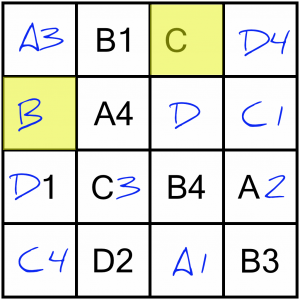
The knock-on effect of that is two easy cells. The B cell takes the only missing number from the column (2), and the C cell the only missing number from the row (also a 2).
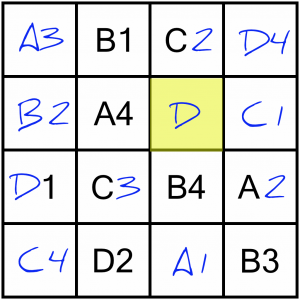
Only one left, so that’s the easiest of all to fill in!
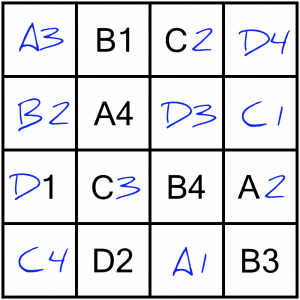
Done! I told you it was a simple one. Ready to try a few yourself? Read on for a free taster, and where to get some tougher puzzles…
We’ve put together a taster of four puzzles for you, including the example above. You can download and print the PDF below. Solutions are included, just in case you get stuck.
We include Eulero in Puzzle Weekly from time to time. Puzzle Weekly is our free weekly puzzle magazine – find out more, and get your copy, here.
You can also find Eulero in our Jumbo Adult Puzzle Book – which happens to include more than 500 puzzles of 20 different varieties.